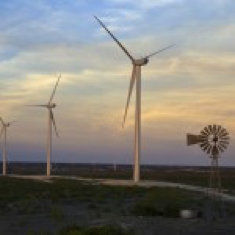Q: What is wind energy?
A: Wind energy is actually a converted form of solar radiation/energy. The sun heats the earth at different rates, varying by the time of the day (day vs. night) and the surface absorption rates (land vs. water). Hot air rises, reducing the atmospheric pressure at the earth’s surface, and cooler air is drawn in to replace it. The result is air in motion, also known as wind. Wind energy is the energy extracted from the movement of air that is converted into electricity.
Q: What is the energy payback time for a wind turbine?
A: The “energy payback time” is a measure of the net energy value of a wind turbine. In other words, how long does the turbine have to operate to generate the amount of electricity that was required for its manufacture and construction? Several studies have looked at this question over the years and have concluded that wind energy has one of the shortest energy payback times of any energy technology. A wind power plant typically takes only a few months (3 to 8, depending on the average wind speed at its site) to “pay back” the energy consumed for its fabrication, installation, operation, and decommissioning.

Q: What impact does a wind turbine have on the land where it is placed?
A: While a wind farm may be installed on a large area of land, many land uses, such as agriculture and ranching, are compatible with its land requirements. Only small areas for turbine foundations and infrastructure are unavailable for the landowner’s use after project construction. Typically less than 2-3% of the total project area is unavailable for use.
Q: How much electricity does one turbine generate?
A: The output of a wind turbine depends on the turbine’s size and the wind speed at the site. Utility- scale wind turbines available today typically range from 1.5 to 3.0 megawatts (MW).
Q: How many homes can one wind turbine supply with electricity?
A: A modern wind turbine can produce enough electricity in a year to meet the average annual energy needs of up to 500-1000 U.S. homes.
Q: How is a project site selected?
A: Wind resource at a site is assessed to determine if there is enough wind. Meteorologists visit the site to analyze the site’s characteristics. Sophisticated terrain and meteorological models are used to estimate wind speeds. Site-specific meteorological studies are performed by installing one or more meteorological towers on the site to collect wind speed and direction data. A minimum of one year of wind data is typically collected to determine the economic feasibility of a project. Beyond wind resource, the following issues are also considered in site selection: terrain, proximity to and available capacity on transmission lines, access to roads, permitting requirements, environmental aspects, and support of local community.
Q: How are the locations of the wind turbines chosen?
A: Wind resource data and sophisticated terrain modeling software are used in conjunction with landowner requests, any environmental sensitivities and/or permitting constraints, and other studies to determine the optimal location for each turbine.
Q: How are land use agreements arranged with the landowners?
A: TGP works closely with landowners to understand each landowner’s unique circumstances and needs. Our wind energy projects provide an additional source of landowner revenue while preserving existing land use. We take pride in working closely with the landowner throughout all phases of a wind project. Typical easement or lease agreements have a pre-construction period during which TGP will pursue permitting, grid connection, power sales, renewable resource assessment, site design and other activities. If development is successful, the pre-construction period is followed by construction and then the operation period, which typically lasts for thirty years, with options for the project to extend an additional 20 years at the end of the initial term.
Q: Are wind turbines noisy?
A: Noise has been largely eliminated as an irritant to nearby residents through improved engineering and appropriate use of setbacks from nearby residences. Blade aerodynamic noise has been reduced by changing the thickness of the blades’ trailing edges and by making turbines “upwind” rather than “downwind” so that the wind hits the rotor blades first, then the tower. A small amount of noise is generated by the mechanical components of the turbine. To put this into perspective, a wind turbine 1,000 feet away from a house is said to be no noisier than the reading room of a typical library.
